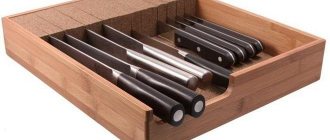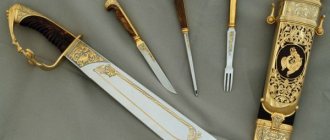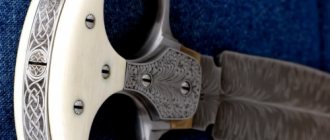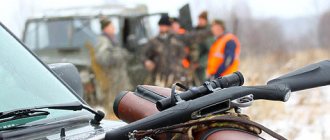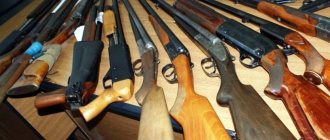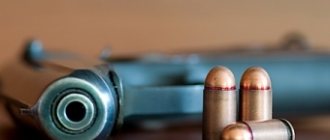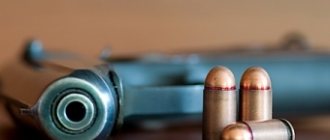Signs of a bladed weapon are a blade larger than 9 cm, a handle from 7 cm, a spine thickness of 2.5-6 mm, steel hardness from 42 HRC, a type of handle with protection from injury, a sharpened blade, a point up to 70 degrees.
Hunting, military, and sports products may fall under this category. And not only knives, but also daggers, stilettos, dirks, axes. Then the owner will need permission to carry, as will those for whom such a weapon is part of the national costume or a reward for service.
A little history - knives in the USSR
The attitude towards knives in the Soviet Union was extremely negative. The products sold were meager in their characteristics and belonged to edged weapons. The purchase of such blades was permitted only with a hunting license.
The knife market itself was quite meager and primitive. Legislative norms played an important role. Illegal acquisition and possession of bladed weapons was punishable by the criminal code. The use of a product, even if it was not a chemical weapon, for the purpose of self-defense, led to condemnation.
Of course, the criminal world ignored these laws. The legality of wearing the product was of little concern to the criminal who was about to commit a robbery or murder. Often, household knives acted and continue to act as tools for murder.
An awl or a screwdriver can become the same tool for committing a crime. Potential victims did not benefit from the strict ban on edged weapons. The lack of quality products on sale has led to an increase in the number of handicraft knives.
You could also get a prison term for production. Among such products there were some noteworthy specimens. But of course they cannot compare with today's factory products.
What knives are not considered bladed weapons by law?
Follow the letter of the law!
Russian legislation clearly describes the characteristics of edged weapons. If according to one of the signs the blade is not a chemical weapon, then there will be no problems with the law. But as soon as you use the blade as a means of self-defense, the situation can change dramatically.
This article will not discuss the topic of self-defense.
Let's talk better about carrying the product with you and how to do it correctly.
In the 90s, carrying products with them completely changed people's consciousness. Any blade, even with a small blade, evoked associations with banditry.
In the old days, every criminal element carried a knife with him. This greatly distorts reality. The presence of a blade still causes negative emotions among others. A person who has a knife with him should not be perceived negatively; he is not necessarily a murderer.
Signs of edged weapons and parameters
Considering all the physical parameters of a knife together, we can draw a conclusion about its relationship to edged weapons. The length of the blade, the thickness of the spine, the quality of the steel, and the features of the handle play a role here. These parameters are specified in GOST.
And also in federal law. The requirements apply to all products, even handicrafts. There are 5 main signs of edged weapons:
- blade length more than 9 cm;
- the thickness of the butt ranges from 2.5 to 6 mm;
- steel hardness from 25 HRC;
- one notch for a finger or guard should not exceed 5 mm;
- sharpened blade.
To recognize a knife as a household item, at least one of the above conditions must be met. But in some cases, edged weapons can only be identified after an examination. And during its implementation, the moment of sharpening the blade is considered very controversial.
After all, it can be recognized as such if it only cuts paper. The most important point is the characteristics of the blade. A knife does not fit the definition of a bladed weapon if:
- piercing is problematic when the tip is raised above the butt line by more than 5 mm;
- There is a rounded tip, which is intended for performing household work. It is impossible for them to stab; such a blade is not recognized as a bladed weapon;
- a hook is located at a distance of 1/3 of the length of the blade from the tip. This design is found in fishing products;
- anatomical handle with cutouts for fingers, their depth should be no more than 4 mm;
- the butt has a deflection of 5 mm, and its length is up to 180 mm. Or the first indicator is 10 mm, and the second is from 180 mm. It is difficult to deliver a piercing blow with such a knife;
- a sawn blade removes it from the group of edged weapons;
- a plastic, aluminum or wooden knife is not a chemical weapon;
- the line of the blade and butt form an angle of more than 70 degrees. It is also quite difficult to stab;
- Butterfly knives are very difficult to define, but the only thing that can be said for sure is that the diameter of the barrel-shaped handle at the top should be no more than 8 mm;
- it is impossible to strike with a knife if the handle is bent upward by more than 15 mm;
- the limiter at the blade or the recess for the fingers should not exceed 5mm;
- a blade that does not hold well in the handle and does not hold during movements automatically excludes the product from the chemical weapons category;
- bending of the butt blade towards the inside in the form of a rocker arm. When drawing a straight line from the tip to the top point of the handle, it must be more than 15 mm;
- it is allowed to use a special sharpening of the butt, in the form of a serrator or saw;
- The handle size is less than 70 mm, and there is no recess up to 4 mm deep, as well as a stopper. Such a product poses more danger to a person who wants to strike.
Knife parts.
All listed permits or restrictions are considered basic in accordance with GOSTs. According to which, the product is removed from the chemical weapons category. Listed below are three GOSTs that define the main characteristics:
- P51644-2000 “Cutting and skinning knives”;
- P51501-99 “Tourist and special sports knives”;
- R51215-98 “Melee weapons. Terms and Definitions".
Rules for storing firearms
According to regulatory federal law No. 150, it is unacceptable to keep service firearms and civilian weapons in the public domain. It is necessary to purchase a special metal storage unit. May be kept together with ammunition. The second rule is that it must be kept in accordance with the place of registration indicated in the license.
Common myths:
- fastening the storage to the floor, wall;
- separate storage of ammunition;
- the need to collect, charge;
- alarm required;
- window grilles need to be installed;
- An electronic lock must be installed.
The list is easy to continue. Similar myths gave rise to legislative changes of the last century. Storage relocation is now allowed. The action should be coordinated in advance with the district or local branch of the Russian Guard or the National Guard.
What knives are prohibited in Russia
Whether a topic is allowed or prohibited is a very fine line, which is calculated in millimeters. There are products that even an ordinary person can tell is a murder weapon. And there are knives where it is very difficult to determine whether it belongs to chemical weapons. In Russia there is a list of products prohibited for free sale:
- A weapon of criminal elements from the 90s, a butterfly knife. For a long time, experts could not come to a consensus on which category to classify this product into. It was decided to ban knives and blades whose blades extend due to gravity or accelerated movement. And due to this they are fixed. But the restriction only applies to knives with a blade larger than 90 mm.
- Dagger-type knives are considered edged weapons in the Russian Federation. But there are small nuances. The law does not prohibit products with a cutting edge on one side and if the false blade is sharpened by 1/3 on the other. But further sharpening is prohibited, even with a serrator. Such knives are permitted for hunting and commercial use.
- Interesting knives related to edged weapons are stilettos. In appearance they are piercing products. And they do not have a cutting edge. To stay within the law, you can sharpen one side of the blade, but its length should not exceed 150 mm. Special restraints are made on knives to remain legal.
- The legislation of the Russian Federation does not like various mechanics. Flip and front-facing products with a blade length of more than 90 mm immediately fall into the cold category. It’s difficult to say why exactly this is so, most likely it is due to the same principles as with butterflies.
Expert opinion
Konstantin
Since childhood, I have been interested in knives and everything connected with them. I bring the accumulated knowledge to the masses. I make knives myself. I take criticism positively, but I also like to argue.
Legislation differs in different countries. The import and export of products must be regulated. If you are trying to smuggle knives into a country, then study the legislation of that state. And in Russia, try to purchase products from official representatives with a set of documents.
Products made in Russia are all accompanied by certificates and rules of use. In real life, it is better to have documents with you, this will simplify the inspection procedure by law enforcement officers. If you are making knives yourself, be careful, otherwise you can sew on making knives.
Products prohibited in Russia.
Law on carrying bladed weapons
In Russia, anyone can get a license. But only so that the person is not registered in a psychoneurological or drug treatment institution. Paramilitary organizations also receive a license for a period of 5 years.
A license is not required for sports equipment. The law defines the circle of persons who have the right to carry bladed weapons. These categories include the following people:
- officials in the performance of official duties;
- retired military personnel who have chemical weapons as a souvenir and have received permission to carry it;
- citizens when transporting goods for self-defense;
- who are engaged in hunting;
- athletes in competition;
- persons at cultural events.
Buying hunting knives
Who has the right to purchase hunting knives?
It is allowed to purchase hunting knives from the age of 18, if you have a permit to store and carry hunting weapons (permit of the ROX series for smooth-bore or rifled hunting weapons).
What documents are needed to purchase hunting knives?
- passport;
- permission to store and carry hunting weapons (permit of the ROX series for smooth-bore or rifled hunting weapons).
Hunting knives are not registered in licensing departments. When sold, they are registered by employees of gun stores in the books of a legal entity.
How many units of hunting knives can you purchase?
This quantity is not limited. You can buy at least a hundred of these knives. No collecting license required.
Types of bladed weapons
Based on the principle of operation, edged weapons are divided into hand-to-hand and throwing. To use hand-to-hand weapons, muscular strength acts as a source of energy. Such products include a dagger, saber, checker, mace and others. But we are looking at bladed weapons, they come in different types.
Hunting
Hunting products are recognized as edged weapons if they are: a dagger, stiletto, cleaver, spear, spear or knife. But in order to remove the knife from restrictions within the law, the following requirements must be met.
The length of the blade must be no more than 90 mm; the blade should not have a double-sided sharpening. The handle should not contain a stop of more than 5 mm, or, of course, the thickness of the butt should not exceed 2.5 mm.
Examples of hunting knives.
Slashing
The following types of battle axes can be called chopping products related to edged weapons: labrys, berdysh, beard-shaped, tomahawk, chased and valashka. Also included in this group are cutting and piercing cleavers, broadswords, sabers, daggers, axes and swords.
The blade of each product must be sharpened, otherwise it ceases to be a bladed weapon. And you can own such a product without a license and not be afraid of a fine. Collectors and participants in various reconstructions can use any type of these weapons, without a sharpened blade.
Axes.
Combat
The following blades can be classified as combat edged weapons:
- police officers;
- products of military units - knives, bayonets and daggers;
- civilian, which is part of the national costume.
All products can be classified as chemical weapons if the previously mentioned signs are present. In the absence of at least one of them, the item becomes allowed to be freely owned and worn. An example would be a knife with a spine thickness of 2.4 mm, or it has a blade less than 9 cm.
Combat knives.
Combined
The combination of several tools at once is called a combined product. These include several varieties:
- multifunctional products that contain, in addition to a tool, a knife;
- firearms with a piercing and cutting object, an example is a rifle with a bayonet;
- a weapon with a secret, when one product hides another, an example here would be a dagger in the handle of a mace or a pike in a sword.
A product can be classified as a bladed weapon based on the same characteristics as in previous cases. Sometimes such special devices are quite difficult to classify; this must be done by a specialist.
Combined weapons.
Sports
The following types of sports equipment are prohibited in general circulation: spear, epee, saber, rapier, sword and throwing knives. But the presence of signs of bladed weapons should be taken into account.
The swords and rapiers used by athletes in training and competitions are specially made so as not to go beyond the law. Throwing knives are also sold in stores with an unsharpened blade. Only the upper part of the blade remains sharp.
Sports equipment.
FAQ
What is the history of edged weapons?
It appeared as a hunting one, that is, almost simultaneously with humans. At first these were clubs and clubs with fragments of stone, then flint knives. When copper was discovered, swords, arrowheads and spears appeared, then bronze tools. Under the Roman Empire, iron swords began to be made, and later sabers. Later, polearms and throwing weapons (spears, halberds, knives, darts, axes) appeared.
Why are edged weapons called edged weapons?
It differs from “hot”, that is, fire, in that use is not caused and is not accompanied by the release of heat or combustion of any substances.
Is a folding knife a bladed weapon?
Yes, if its blade is more than 9 cm, the handle is protected from injury and longer than 7 cm, the blade is sharpened, the tip is not rounded, and the thickness of the blade is 2.6-6 mm. No, when the knife parameters do not correspond to those specified. The fact that a weapon folds does not make it prohibited.
Can I carry a knife with me?
Yes, if it does not meet the criteria for edged weapons.
Is a machete a bladed weapon?
No, if it has a certificate that it is a household tool. Yes, when the technical characteristics of the product correspond to edged weapons.
How to distinguish a bladed weapon from a simple knife?
Take your own measurements or submit them for examination.
Is a kitchen knife a bladed weapon?
No, this is a household product.
Is kukri a bladed weapon in Russia?
Most often, no, this is a household appliance. But you need to look at the characteristics and compliance of the kukri with the requirements for approved knives.
What knives are considered civilian edged weapons?
In accordance with Article 3 of the Law “On Weapons” this is:
- bladed and throwing, used for sporting and hunting purposes;
- Cossack checkers, sabers and other types belonging to national cultures (they are worn with costumes);
- antique knives, their replicas and copies, products of cultural value.
What edged weapons are prohibited in Russia?
Flails, brass knuckles, boomerangs, shurikens and other shock-crushing and throwing products, if they do not have cultural and scientific value, are not sports equipment.
Is an ax a bladed weapon in Russia?
Ordinary - no, this is a household or industrial tool, about which there is information in the certificate for it.
Is the manufacture of bladed weapons allowed?
No, there is clause 4 of Article 223 of the Criminal Code of the Russian Federation, which prohibits this and regulates penalties for craftsmen.
We recommend reading the article on types of knives. From it you will learn about the basic shapes of knives, their names and characteristics, the materials of the knife blade by type of metal, as well as the rules and criteria for choosing a knife. Find out more about the best switchblades here.
Even a kitchen knife and a pocket knife can become dangerous, but this does not negate the threats that real edged weapons pose. Therefore, amateurs and collectors of such items should order an examination of the product before purchasing. And if it is recognized as a weapon, stock up on a license to own it.
At what age can you carry edged weapons?
It is surprising that some people teach children to use knives from a very young age. Already at 2-3 years old, a child knows from which side the product is pricked, and from which side it must be picked up. And by the age of 4-5, they make special homemade small knives for children.
They learn how to use a knife correctly and how to cut various fruits and vegetables.
They also show the child that cutting stone and metal with a knife is prohibited. This is mainly how boys are introduced to blades, but sometimes girls get involved too.
The culture of handling knives from childhood is the correct approach of parents. According to the legislation of the Russian Federation, edged weapons are permitted after obtaining a license. And it is issued after 18 years. If the law is broken, the parents will bear responsibility.
How to obtain permission for a storage and carrying license
To obtain a license to carry and store bladed weapons, you need to collect a package of documents. Basically, as a rule, you need to collect:
- Photos 3x4 2 pcs.
- Write an application, the form is available on the Internet.
- Medical certificate with all notes.
- Receipt for payment of state duty.
- Inspection report of the storage location.
- Passport and its copy.
A license is issued for a period of 5 years, then it will have to be renewed. The application is considered for about one month.
How to buy a hunting knife legally
After receiving permission to carry and store chemical weapons, a hunting license is issued. You should act according to the following plan:
Permitting department
To purchase a specific type of bladed weapon, approval is required from the licensing department. He issues a special right to purchase it.
Purchasing a product
Then you should go to the store and buy a knife. There will be a note on the hunting ticket about the purchase of the product.
Knife certification
Having received the item in your hands, you should go to law enforcement agencies and have the knife certified. A special document with a registration mark is issued.
This paper gives the right to carry and store weapons. You can easily buy a knife that passes the law. No certificates or permits are required. The store will issue a certificate that gives you the right to carry the product with you. It is best to always have this document with you.
Permit, license or certificate?
All permits are issued by the Licensing and Permitting Department (LPR) of the Ministry of Internal Affairs at the place of registration of the applicant. You can find out the location of the OLRR when choosing a weapon in a hunting store. The seller is obliged to issue a certificate for the selected blade model for review. Not every knife requires a license or permit, but having a certificate holder is highly desirable in case of law enforcement interest. Any knife belongs to a “piercing-cutting” instrument, but does not fall under the definition of “prohibited to be carried” if you have the appropriate confirming certificate on hand.
- The license (see Article 9, Federal Law-150 “On Weapons”) for the acquisition of collectible edged weapons is valid for 6 months, giving the right to collect and exhibit – indefinitely.
The acquisition of sporting and hunting bladed weapons is not licensed.
Required documents:
- Application in the approved form.
- Identity card of a citizen of the Russian Federation (passport).
- Two photos 3x4 cm.
- Data on the conditions for storing weapons (a report with a conclusion is drawn up by the district police officer).
There are no monetary fees when issuing a license.
- A license (at the same time a permit) for wearing with a national and Cossack uniform ( Article 13 of the Federal Law-150 ) - for a period of 5 years, available to citizens of the Russian Federation who have reached the age of 18 years. Up to 5 units of the specified weapons are purchased under one license; within two weeks they must be registered with the federal executive body.
- Permit for hunting bladed weapons – Article 13. FZ-150, for citizens who have a permit for hunting firearms (hunting license).
In both cases, the following are added to the previously specified list of documents:
- medical certificate confirming the absence of contraindications to owning a weapon
- confirmation of payment of the state duty (from October 2022 it is 500 rubles).
The easiest way to obtain permits is in your personal account on the State Services ; to do this, you need to find it in the Ministry of Internal Affairs (Security and Law and Order) section.
Obtaining a permit for edged weapons through State Services
To obtain a license or permit, however, you will have to contact the licensing and permitting department (the address to which you intend to apply is indicated when registering the application on the State Services website). All electronic copies of documents attached to the application must be clear and easily readable.
When submitting an application through the State Services service, a permit document is issued within 2 weeks from the date of application.
- For all other types of blades, a certificate is required confirming that the blade worn by the owner is not a bladed weapon and is not prohibited for circulation on the territory of the Russian Federation (for some types of knives, the bases are shown in the table; a certificate for any legally produced brand of knife can be found on the Internet on the forums " knife makers").
| Blade type | The reason why knives are not edged weapons | Note |
| Cutting and skinning | An injury-proof handle is acceptable for a blade thickness with a butt thickness of up to 2.4 mm inclusive | A variant of an acceptable barrel-shaped safety handle without a limiter with a difference in minimum and maximum diameters of over 8 mm |
| Folding knives with blade length up to 150 mm | If in the folded position the blade does not exceed the length of the handle | excluding knives with dagger or stiletto blades |
| Nepalese kukri knives, karambits | upward deflection (see figure) more than 15 mm | |
| Serrated (wavy or sawtooth cutting edge) | Not mentioned in prohibiting articles of the law |
How to wear and store correctly
Russian legislation does not regulate the carrying of a knife. But there are places where it is better not to take a knife with you. Nobody legally prohibits you from taking a knife with you to crowded places, concerts or sporting events.
But there are certain norms in such places. You must use common sense or you may not be allowed through by security. Leave the product at home or in the car. And if you manage to attend such an event, don’t flash your knife again.
There is no need to attract unnecessary attention to yourself. And it looks too provocative, which may attract the attention of law enforcement officers. If you hide a knife in your sleeve or behind your back when an unpleasant situation arises, you may be accused of being secretive.
Do you have permission to carry and store bladed weapons?
Not really
It’s easier not to hide the product and hang it on your belt, covering it with a piece of clothing. Traveling by air can have its own difficulties. You will need to present documents for the product and place it in your luggage.
There should not be even small objects of a piercing or cutting nature in the aircraft cabin. If there are no documents, the product may be confiscated and placed in temporary storage. And only when you return and present all the necessary documents, the knife will be returned to you.
But unfortunately, everyone knows how such services work for us. The knife may get lost, don’t take unnecessary risks, carry the documents with you. There will be no problems with sea transport. It is not recommended to display the product in any situation; behave more modestly and everything will be fine.
Differences between household knives and edged weapons
According to the principle of purpose, knives are divided into household knives and edged weapons. The latter are structurally designed to defeat a person using muscular force. Household weapons are not structurally designed to hit a target.
But in the hands of a criminal element, such a product can become a murder weapon. But in this case we are talking about the design of the product itself. It was not originally intended for such purposes. In accordance with GOST, knives are not considered cold steel under the following parameters:
- Blade less than 90 mm long.
- Rounded tip tip. With such a knife it is impossible to stab.
- Products with a handle less than 7 cm.
- With a tip that is 5 mm above the butt.
- Products with a blade 5 mm lower than the butt when its length is 18 cm, and also 10 mm lower when its length is more than 18 cm.
- The presence of a hook on the butt.
- Items whose blade is not sharpened.
- The thickness should not exceed 2.5 mm.
- Steel is not hard enough.
To avoid problems with the law, you need to know the parameters of your blade. Please note that sometimes legislation changes. The above parameters clearly indicate the differences between a simple knife and a bladed weapon.
Cold knife knives.
How to buy correctly
A bladed weapon is any product related to the hunting, sports or military sphere. At the same time, their action is in no way related to energy carriers and explosives, however, when used, these products can cause a serious injury to a person or cause death.
Article 1 of Federal Law 150 gives a slightly different definition. Thus, the law establishes that edged weapons are a product used to hit a target in close contact with it using muscular force (physical impact).
This type of weapon includes a variety of knives, daggers, sabers and brass knuckles, stilettos and much more. At the same time, the law does not include various household and household appliances, in particular kitchen, garden and pocket knives, in the category of edged weapons.
In accordance with Russian legal principles, edged weapons have the following characteristic features:
- you need special limiters (without them it is difficult to plunge the knife into the target deeply enough and safely for the person wielding it);
- the blade length is over 9 centimeters, it is from this size that the knife can begin to be considered a real weapon; ⇐
- blade thickness – from 0.24 cm;
- the angle of contact of the blade with the butt is less than 70 degrees;
- bending deviation – 0.9 cm;
- characteristics of the minimum hardness of the metal (steel) – 25 Rockwell;
- the depth of penetration of the blade when hitting a target is more than 2 cm. The most striking example here is the checker.
The following categories of citizens have the right to carry bladed weapons by law:
- law enforcement officers on duty;
- citizens whose activities are related to hunting;
- athletes for whom owning a weapon is a professional duty;
- retired military personnel who use edged weapons that have trophy status;
- citizens attending thematic cultural events dedicated to weapons (selling antiques);
- users accompanying various cargo during transportation and transportation as a self-defense item.
A permit for bladed weapons will be required in a situation where it does not fall under the category of “civilian use.” If a particular knife has parameters indicating that it belongs to a real weapon, the owner will need to obtain special permission.
FZ-150 establishes a number of functional prohibitions regarding weapons.
The following types of weapons that could be used for civilian and official purposes and are classified as high-risk products are strictly prohibited for circulation:
- stun guns with increased power;
- brass knuckles;
- firearms that imitate the shape of other objects;
- armor-piercing cartridges.
Regarding bladed weapons, the list of prohibited items is much smaller. Thus, knives with automatic opening, as well as objects with a blade length of more than 90 mm, are completely prohibited for free circulation.
Also prohibited are weapons of a throwing nature (surikens, boomerangs), and objects with shock-crushing action.
According to the current provisions of the Russian legislative framework, brass knuckles are classified as a special category of edged weapons that have a shock-crushing effect.
Such items are prohibited for sale and carrying on the territory of the Russian Federation, and violators will face criminal liability! Especially severe punishment threatens those for whom the use of brass knuckles is in the order of things.
The law allows you to carry a bladed weapon whose blade length does not exceed 9 cm. If situations arise where it is necessary to verify the involvement of the weapon owner in a crime, a special examination will be carried out.
Federal legislation establishes certain temporary restrictions on the free carrying of weapons. So, if an item has household or economic use, you can wear it from any age.
True, you cannot take it with you to public places, airports, public areas with a large number of people, parades and other cultural events. Although, in the event of problematic issues involving minors, responsibility rests with the parents (guardians).
To obtain permission to store and carry weapons, you will need to contact the police department at the citizen’s place of residence. You will need to write a corresponding application and attach a copy of your passport data and 2 passport-type photographs. The applicant must meet only one requirement - to be an adult.
After checking the application, the Department of Internal Affairs makes a decision to issue a license and carries out a procedure such as registration.
For citizens wishing to purchase a hunting knife (a weapon prohibited for the general public), there is a mandatory requirement to register a dangerous item and obtain the appropriate permit from the state.
Using a hunting knife without a permit is a violation and is punishable according to the applicable state requirements.
Only companies that have certificates for activities of this nature can engage in the production of products belonging to the category of edged weapons in Russia.
If illegal manufacturing is detected, the law establishes criminal liability for violators.
Regarding violations related to the storage, carrying and production of bladed weapons, the law provides for both administrative and criminal sanctions.
Administrative punishment will be determined, and permissible liability will appear in the form of:
- a fine of 500-5000 rubles (depending on what signs of the offense are identified);
- removal of a dangerous item;
- The administrative code allows for a thorough investigation into the circumstances of the receipt of weapons, as well as their possible involvement in criminal acts.
The punishment under the Criminal Code is much stricter:
- compulsory work for 480 hours;
- correctional labor for 2 years;
- restriction of freedom for 2 years;
- imprisonment for 2 years;
- a fine in the amount of 50-80 thousand rubles or in the form of income for 6 months.
It must be established that illegal purchase of a prohibited product is also punishable.
Amendments to federal legislation on bladed weapons are carried out regularly. The legislator is constantly tightening the requirements for owners of dangerous items.
Among the latest changes affecting Federal Law-150 are:
- Citizens caught poaching will lose their licenses for permitted weapons and will be expelled from the hunting community.
- Users who have more than 2 protocols for non-payment of fines for traffic violations within a year will lose their license and face the confiscation of a dangerous item.
- The possibility of revoking permission for citizens in debt is being discussed. What kind of debt exactly is not yet indicated.
Important
And the local police officer is obliged to check the conditions of its storage. And if not... Do you hope that when imposing an administrative penalty, they will take into account complaints: “Oh, well, I didn’t know that this was chemical weapons”? Then, perhaps, you can store the machine gun.
Do you really think that I have to rush like a moose to a watering hole with every piece of hardware without an expert certificate? Until SOMETHING is recognized as XO, it is not XO. Just from your point of view, if I buy a toy gun and a local police officer suddenly comes to see me, they have to arrest me for illegal possession of firearms because the CM decided that it was a weapon, not a toy.
Vsevolod 01/22/2008 14:52 Not at all.
Attention
But not the entire amount will be returned to you: part of the money will be taken by the appraiser, and part by the trading organization. Let me emphasize: we are only talking about a situation where you were just walking with your blade and haven’t done anything yet.
Info
The authors of weapons innovations propose to further strengthen responsibility. For repeated violation of the ban on carrying bladed weapons - a fine of up to 50 thousand.
rubles or arrest for 15 days. If the police stop him for the third time within a year, he’ll end up in jail. Namely: imprisonment for up to two years and a fine of 200 thousand.
rubles On the grounds that cases of the use of piercing and cutting objects in street conflicts have become more frequent. The most resonant case is the tragedy in Solntsevo near Moscow.
What restrictions do people have regarding edged weapons? The law states that citizens of any professional activity cannot, at their discretion, use edged weapons in the following cases:
- send by mail
- wear at processions, rallies, demonstrations
- carry to use in self-defense
- athletes store and use copies only in the area of the sports facility
The law prohibits:
- acquire and store weapons items that do not comply with legal requirements
- have boomerangs, brass knuckles, and also use them, since the punishment for use is much more severe than simple storage
Possession of sabers and blades is not punishable by criminal laws, but it is important to remember that using them with criminal intent will result in severe punishment.
A person who voluntarily surrendered the items specified in this article is exempt from criminal liability under this article. (as amended by Federal Law No. 306-FZ of December 30, 2012) Article 223.1.
Illegal manufacture of explosives, illegal manufacture, alteration or repair of explosive devices (introduced by Federal Law of November 24, 2014 N 370-FZ) 1. Illegal manufacture of explosives, as well as illegal manufacture, alteration or repair of explosive devices - is punishable by imprisonment for a term of from three to six years with a fine in the amount of one hundred thousand to two hundred thousand rubles or in the amount of wages or other income of the convicted person for a period of one to two years.2.
Important
You can receive an “information sheet” upon purchase. It contains a description of the knife itself, an expert opinion, date and number, as well as the coordinates of the competent authority. Typology In accordance with the law, depending on the purposes of use by certain entities, as well as on the basis of general parameters and characteristics, all weapons are divided into:
It is intended for use by various government officials and legal employees. persons who have the right to store, use and bear arms.
- Civil. It is intended for use by Russian citizens for self-defense, hunting or sports.
- Combat cold and hand rifle.
Attention
It is especially prohibited to use and wear devices made without permission at home or in other non-standard conditions. It is also strictly prohibited to use any type of bladed weapon during rallies, parades, or any other organized events. Weapons allowed for operation The right to purchase and further use edged weapons is not given to every citizen of our country who wishes to do so.
But to purchase this paraphernalia, a special permit is issued.
Responsibility for illegal possession, carrying or manufacturing
There is no point in quoting articles of the criminal code No. 222 and No. 223. If there was a murder, there is no need for an examination. There is an object that was used to kill a person. But when wearing a product without documents for it, the situation is different.
Law enforcement agencies like to arrange various examinations.
This mainly applies to homemade knives and souvenirs. Illegal carrying or storage of bladed weapons is punishable by a fine of 500 to 2,000 rubles.
As well as deprivation of the right to purchase and possess weapons for a period of 1 year. The product will be confiscated. Production and sale are punishable by imprisonment for up to 2 years and a fine of up to 80 thousand rubles or without it. Be careful and be friendly with the law.
Dirks
The right to own a dagger, which is a combat bladed weapon, is granted to employees of state paramilitary organizations who have been retired with the right to wear a military uniform.
They get the opportunity to own not just any dagger, but a specific copy issued upon dismissal.
This dagger is registered with the LRR unit of the Russian State Guard, where a permit from the RHNK series is issued for it (for storing and carrying a separate model of combat edged bladed weapon (dagger).
permissionsGetting permission to use dirkarticle
Dirk can be inherited
after the death of the owner, the heir is issued a permit from the RHK series (for storing a separate model of combat bladed weapons (dagger).
If you are interested in the issue of purchasing daggers that are antique weapons - manufactured before 1945, then their legal purchase is regulated by the same rules as the acquisition of weapons of cultural value, copies and replicas of antique weapons.
